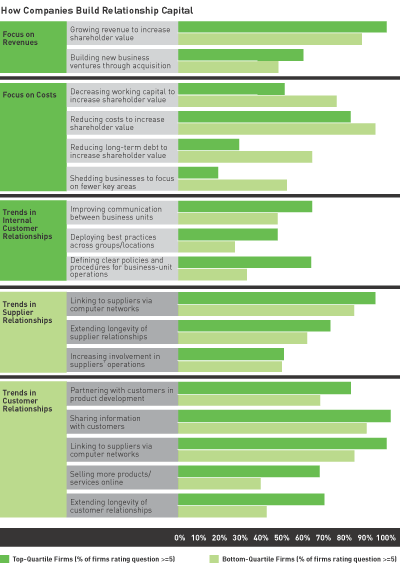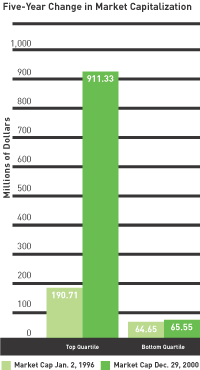From Solutions to Symbiosis: Blending with Your Customers
It’s not enough to know your customers. You have to integrate them into your company.
American Healthways Inc. knows something about curing intractable problems. The disease-management firm primarily provides specialized care to patients with heart disease, diabetes, asthma, and other chronic conditions that require a great deal of attention. Last year, though, American Healthways had to find a remedy for a sick company.

Blue Cross and Blue Shield of Minnesota, one of its most important customers, was squeezed between rising medical costs and the unwillingness of its own customers to pay more for health insurance. To get out of this stranglehold, Blue Cross needed to find a way to reduce the expense of caring for its worst-off patients — the 15 to 20 percent who accounted for 75 to 80 percent of the medical outlays. American Healthways offered an innovative approach: Instead of just selling disease-management services and leaving Blue Cross responsible for the reductions in cost and improvements in patients’ health, it offered to reorganize the relationship between the two companies to accomplish both goals, accepting increased downside risk and the opportunity for greater upside reward.
Today, American Healthways nurses oversee the care of Blue Cross’s most persistently ill and costly patients with regular, individualized over-the-phone attention; its payments for this service depend on Blue Cross’s cost savings, and on whether regular contact with nurses improves patient health. If American Healthways meets the fiscal and health-care benchmarks set down in the Blue Cross arrangement, its fees over a 10-year period could reach $300 million — a significant benefit for a company with $75 million in revenue in 2001.
Real Solutions for the Real Economy
The inventive response of American Healthways to Blue Cross’s painful market challenge is a fitting illustration of a new business tactic known as a solution — a response to the query, “Where do our customers have to go to succeed in the marketplace, and how can we be a partner in helping them get there?”
Although the concept of customer solutions is new and unfamiliar in most industries, that hasn’t stopped the phrase from becoming one of business’s most overused terms. Sixty-three percent of the Fortune 100 already claim to offer solutions, according to a Booz Allen Hamilton survey of public documents and marketing materials. With the highly visible success of bellwethers like IBM Global Services and General Electric’s Power Systems, solutions are a fast-growing strategy for companies caught up in price competition and confronted by the threat of commoditization.
But the term solutions is tossed around carelessly, often unattached to a real solutions strategy. Very frequently, the word solution is merely a costume thrown over a repackaged, existing set of products or services. A real solution, in our view, is a fundamentally different approach that creates additional value for customers and suppliers by meeting five criteria:
- It is co-created by a customer and a supplier.
- It integrates products with services to meet essential customer needs.
- Suppliers accept some of the risk, often through performance-based and/or risk-based contracts.
- Relationships between suppliers and customers are unusually intimate, far beyond a traditional buy–sell relationship.
- Solutions, therefore, are tailored to each customer.
Applying the five-part test can help customers find real solutions among the welter of sales pitches and proposals crossing their desk — a crucial identification, if lasting, beneficial change is the goal. Similarly, the test can help would-be suppliers distinguish their solutions offerings from the pack, and achieve continuing, profitable relationships with existing and new customers.
Many strategies that companies call solutions don’t meet all five parts of our test. For example, the Dell Computer Corporation can tailor a personal computer to suit a customer’s desired configuration; however, there is little or no co-creation, integration, shared risk, or new intimacy involved. The Home Depot Inc. provides customers names of contractors who can install merchandise it sells, and Microsoft furnishes lists of certified software engineers who can support its products, but such arm’s-length referrals don’t create additional value, involve no customer–supplier integration or risk sharing, and are neither tailored nor intimate. Similarly, the myriad firms bundling products and services under the rubric of one-stop solutions shopping aren’t changing the customer–supplier relationship in ways that meet the real solutions test.
That doesn’t mean that customization, bundling, and one-stop shopping can’t benefit both the customer and the supplier. They can and do — but they stop short of creating new, lasting benefits from the transformed dynamics of the customer–supplier relationship, a value-based alliance we prefer to call “customer symbiosis.” Like symbiotic relationships found in nature, customer symbiosis must be a true partnership, built on transferring a supplier’s skills to a customer lacking them. It must be founded on the belief that sharing knowledge and information about business processes and product design can be advantageous to both the supplier and customer. And the parties must share the risk and potential rewards of every transaction related to the collaboration.
Symbiosis Takes Two
The importance of symbiosis has risen from new competitive stresses virtually all companies are facing in globalizing industries, which have plunged them into a dizzying “specialization spiral” that almost mandates a new operating model. Firms are under increasing pressure to differentiate themselves by focusing on core activities where they can apply their superior knowledge to customer needs. This is compelling them to eliminate noncore activities. After doing so, however, a company retains only a limited ability to master the integration of disparate products and services from multiple vendors. Yet dependence on a vendor to do the integration is risky, unless the vendor assumes some of the risk for the performance of the integrated solution.
For an illustration, consider the low returns companies have received from their massive investments in enterprise resource planning systems and customer relationship management systems, which are typically designed and implemented by systems integrators compensated on a time and materials basis. Significant benefits generally are achieved only when customers ask vendors also to share the risk of attaining real results from the new system. That compels the systems integrator and the client to enter into a more collaborative relationship, in which knowledge and skills are transferred across the boundaries that usually separate them, and the line between the information technology products and the services that support their use are erased.
For suppliers, customer symbiosis is a powerful strategy that creates top- and bottom-line growth, deepens relationships with important customers, and enhances customer loyalty. Customer symbiosis can also be a transformative tactic internally, goading a supplier’s culture toward customer-centrism. This was exactly the revolution instigated by Louis V. Gerstner Jr. when he became chairman and chief executive of IBM and tried, as he told the New York Times earlier this year, to “look at technology through the eyes of the customer.”
It was “an incredible bomb in the company,” Mr. Gerstner said. “Here was a part of IBM that was going to work closely with Oracle, Sun Microsystems and, God forbid, Microsoft.” Today IBM Global Services is the company’s biggest business.
A recent survey of the Fortune 1000 companies, jointly conducted by Booz Allen Hamilton and the Kellogg School of Management, provides strong evidence that customer-symbiosis strategies create value for shareholders. Respondents were grouped into quartiles based on their total return to shareholders from 1996 to 2000. During that five-year period, the top quartile generated a return greater than 22 percent; the bottom quartile’s return was less than 2 percent. By a large margin, top-quartile companies say they are outpacing their bottom-quartile peers in all key areas of customer collaboration: partnering with customers in product development; extending the longevity of their relationships with customers; and placing more focus on meeting customer expectations. (See “Focus: The Value of Relationship Capital.”)

|
Although customer symbiosis has enormous upside for both suppliers and customers, the barriers remain formidable. Most suppliers are structured with strict boundaries separating product lines, and with R&D focused on creating the next iteration of a product, rather than on tailoring it for customers’ incremental gains. Changing these habits and the structures that support them requires a difficult overhaul of the corporate culture. Companies may find it necessary to reinvent their strategies and operations, and even economic measures, to concentrate on customer needs and on the lifetime value of customers, not just transaction profitability. The business model may have to be retooled to allow teams to develop solutions by combining products and services that exist across a company’s entire set of offerings, without having turf wars.
Structuring a Symbiotic Relationship
For a supplier, the three keys to a successful symbiosis strategy are:
- Changing its mind-set from one focused on selling products and services to one centered on risk-based, goal-guaranteeing partnerships.
- Developing additional capabilities to be sure that the risks are manageable.
- Creating an intimate alliance that lets customers get inside the supplier — a relationship that true solutions providers speak of as “opening the kimono” to customers.
The first step in a successful symbiosis strategy is choosing the right customer. Even those suppliers that overcome structural and operational barriers to solution provision may find they don’t have the customers whose needs are appropriate for a symbiosis program. Large businesses typically are the best candidates because they need to pursue efficiencies or partnerships to improve margins. Potential candidates have to be willing to try a completely new type of relationship with their suppliers, a joint effort they probably never even considered before. As a result, in most industries, only about 10 to 20 percent of a typical large supplier’s customers would be both big enough to need a symbiotic relationship and culturally flexible enough to be receptive to one. Another 10 to 20 percent might benefit from symbiosis, but want to see proven results elsewhere first. But even though the potential customer base may be only 30 percent of a supplier’s customers, that group of companies should account for a much higher proportion of revenue, profits, and innovation.
The next step toward symbiosis is identifying what can be offered to that customer — specifically, identifying which skills or which products can be individualized to fit the customer’s needs. Going through this often time-consuming process can be difficult for salespeople who are being measured on strict short-term revenue goals. Consequently, it’s critical that chief executives motivate and encourage sales, marketing, and product development staffs by emphasizing the importance of the long-term returns that solutions can bring. Often that means reworking compensation plans and decisions about promotions so that employees working on customer symbiosis aren’t penalized.
It’s also essential for a supplier to produce clear performance benchmarks linked to the solution. A finite measurement reveals whether or not the new partnership is working — a necessary comfort for the customer. For suppliers, these benchmarks are vital because a solution is such a risky and often long-term venture; there must be certainty that with growth in revenue there will be an equal increase in profitability. Finally, suppliers must find a way to provide the symbiosis in a repeatable, scaleable way. Creating each solution with a clean sheet of paper isn’t economical.
The biggest challenge that suppliers face is restructuring how they work with customers. Even after solutions candidates are identified from a supplier’s customer base, designing the partnership is a tedious process. Because the supplier has to sell symbiosis to a customer, it is the supplier that generally has to initiate the arrangement. Generally that means doing a significant amount of advance research to approach a customer with an idea that demonstrates a clear understanding of its business and its business problems. A recent Booz Allen review of public documents indicated that suppliers cited knowledge of the customer and its marketplace as the biggest gap that they had to address. Customers with a need to cut margins and decommoditize their sales channel are frequently very receptive to exploring the potential in symbiotic partnerships.
Throughout the process of crafting a solution, the supplier has to act as the driver because customers may lose interest without regular reminders of the benefits they can accrue from a solution. To motivate customers, the supplier needs to encourage meetings to brainstorm how the supplier’s capabilities can fulfill (and bring a profitable return to) a customer’s needs. At these sessions, sets of workable solutions scenarios should be resolved and then ranked by which can generate the greatest return within the shortest time.
Small successes at the early stages of the engagement are important, as evidence that solutions are effective and to encourage both sides to further their partnership.
|
Symbiosis Readiness: The Five-Point Checklist |
|
1. Customer Trust. Do you have customers who trust your expertise and are willing to share insights on their challenges and needs to succeed in their marketplace? 2. Collaboration. Does your organization team up cross-functionally internally? (If it doesn’t, you will go through false starts when you try to collaborate with the customer.) 3. Innovation. Do you have a process to capture innovation at the customer frontline to drive solution generation? Do you have a process to capture the learning so that you’re able to repeat your success with other customers? 4. Risk Profile. Does your company have the risk profile to invest for future potential returns by the customer? Can you afford to make the economic transition? 5. People and Leadership. Do you have people with a strategic mind-set and the consultative skills to uncover and develop opportunity with the customer? |
How Nibco Benefited
While the solutions agreement is being worked out, it is important to determine the roles and responsibilities of both sides, including benchmarks, expectations, and ways to measure success or failure. Without clear metrics, what was supposed to be symbiosis could dissolve in rancor. A casual handshake deal can doom a solution; a detailed written charter can ensure its success.
An apt example of a well-thought-out solution that followed this protocol is the one forged a few years ago between Dow Chemical Company and Nibco Inc., a $400 million maker of valves and pipe fittings. After watching Nibco struggle with an erratic supply chain for years — orders would come in bunches and then slow down, so Nibco never knew the quantities of materials it needed on hand to manufacture the number of pipe fittings it would have to supply — Dow approached Nibco with this plan: If Nibco agreed to share with Dow the details of its order book, inventory, design, and factory operations, Dow would take over total supply chain management of the resin pellets Nibco needed to make plastic into pipe fittings. Dow promised to stock Nibco with just-in-time inventory that would put the burden of warehousing and filling Nibco’s shelves with each type of resin pellet completely on Dow, and Dow offered a series of performance measurements that it guaranteed would be met, or the solution would be canceled. Simply put, when Nibco needed the supplies, Dow would ensure they would be there even without an order being placed.
At first, Nibco was hesitant to do this because it would mean sharing a lot of information with a supplier to which it would also be entrusting the most critical part of its operations. So the companies agreed to begin by having Dow handle just a portion of Nibco’s resin pellet supply chain. That worked so well that, within months, Dow was managing all of it. Significantly, as a result of this solution, Nibco became a solutions provider also, because it could extend and even customize its product line, while actually decreasing the expense of managing what would turn out to be a much wider inventory. In fact, as the solution has played out, Nibco’s operational costs in its resin pellet business have dropped 15 percent, while its market share among customers drawn to its enhanced offerings has increased. Dow was a beneficiary as well; its orders from Nibco have risen by about 10 percent.
Symbiosis offers CEOs and top business-unit managers at both suppliers and customers clear and critical benefits that all too often are impossible to obtain any other way in this difficult economic environment. Some of the benefits are:
• Improved Operating Performance. Royal Dutch/ Shell Group of Companies’ lubricant program is typical. This solution, which began in Shell’s Brazil operations and has since been extended to other Shell units around the world, is centered on using the company’s vast lubricant knowledge to measure viscosity changes and contamination buildup in its products by closely monitoring the machines that are oiled by Shell lubricants. The aim is to take over from the customer the job of scheduling oil changes and machine maintenance. This differs from the traditional approach of shipping lubricants formulated to customer specifications, but leaving the actual upkeep of the machines (and the use of lubricants to maintain them) in the hands of the customer. The potential improvements in operating performance for Shell’s customers from this solution are readily apparent: It promises superior machine uptime, fewer unscheduled repairs and in-house maintenance responsibilities, and lower lubricant bills. Shell gains as well because, although it actually reduces the amount of lubricant that is sold to each customer, it charges more for the added service and takes on an increased role in its customers’ operations, which ultimately leads to higher revenue.
• Increased Asset Effectiveness. Another benefit of solutions is the creative stretching of existing products, services, and skills to generate additional revenue and efficiency. The largest delivery companies — Federal Express, UPS, Penske, Ryder, and DHL — have been especially active in setting up solutions programs that allow them to handle more and more of the transportation management needs of their customers, often through Web-based communications and software they provide. But Ryder System Inc.’s logistics unit has taken this a long step further with a solution that inserts itself directly into a customer’s supply chain. Beyond just providing basic fleet management, inventory, scheduling, and routing — the typical logistics solutions package — Ryder offers customers an “events management program,” which, in effect, makes Ryder the intermediary between a customer and all of its suppliers. From its perch in the center of the network, Ryder monitors manufacturing and delivery transactions agreed to by its customers and their suppliers and makes sure that the schedule never slips.
One of Ryder’s first customers for this service was Lucent Technologies Inc., which needed both to cut costs and improve credibility with suppliers that had incurred late payments. Lucent uses Ryder-licensed TradeStream software to continually funnel to suppliers real-time manufacturing information and required delivery dates for materials. Ryder, in turn, manages Lucent’s logistics effort by constantly tracking activity on TradeStream and by keeping watch to ensure that each supplier will be able to ship on schedule. If Ryder learns that a shipment will be delayed, it instantly finds a replacement for the order by asking another supplier to speed up a delivery that’s already in the works or by locating a new source.
Interestingly, the way Lucent uses TradeStream to share information with its suppliers about which products are needed and when is, in itself, yet another example of a solution. Lucent’s suppliers can integrate this TradeStream data with their plant-management systems, which alerts them about when exactly they have to begin producing components so that they can deliver materials on time. This also shaves the expense of manufacturing and warehousing inventory until Lucent needs it.
• Expanded Market Share. This benefit occurs almost naturally because underlying most solutions is the motivation to generate more business from customers. New markets are created when a solutions-oriented company listens closely to customer needs and innovatively fills the vacuum — or at other times analyzes consumer sentiment skillfully enough that it offers new products customers may not even have known they wanted.
GE Plastics took just such a proactive approach a few years ago when it asked customers for their product wish lists and told them to include items that they believed were nothing but fantasies. Car manufacturers responded that they needed more plastic body parts to lighten vehicle weight and achieve lower fuel consumption. So GE Plastics designed a solution that involved setting up partnerships with injection molding companies to develop the equipment and manufacturing capabilities to build automobile doors, and then other plastic car parts like hoods, back panels, and now even windows out of plastic. For the molding companies, the solution resulted in an additional product line and new skills that they could use to make other finished items. GE Plastics ended up with a market share coup. It became the first supplier to a customer base to which it didn’t have access before.
Risks and Rewards
Of all the benefits of customer symbiosis, mitigating customer risk is the most uncertain, but also boasts some of the greatest profit potential for suppliers. Most commonly, solutions that promise to limit customer financial exposure are tied to supplying essential commodities, like electricity or even broadband access, whose prices can rise or fall. Suppliers that offer these solutions can generate ever-increasing revenue from customers as these customers expand into new factories and new business lines; in effect, the suppliers edge so close to customer operations — because they’re handling an indispensable commodity — that they become irreplaceable.
But the potential dangers of financial risk mitigation are equally apparent. The Enron Corporation is a very visible symbol of how easy it is to fail at them. Indeed, one of Enron’s biggest mistakes was its lack of fear, as it took on so much of its customers’ financial stake in future energy and other commodity prices that any bad bet could topple the whole company. In light of the Enron disaster, most solutions-oriented companies that promise risk mitigation are now weighing such contracts very carefully against numerous “what-if” scenarios and also offsetting the gamble with financial derivatives or organizational restructuring to cover them in worst-case scenarios.
The solutions relationship forged recently between Reliant Energy Inc. and semiconductor maker Texas Instruments Inc. is particularly robust. Under this two-year contract, Reliant will supply power to 24 Texas Instruments sites, including the company’s Dallas headquarters. TI is paying $100 million for the electricity, about 20 percent below current rates. But it’s also a big win for Reliant: The TI power sales contract is one of the largest in Texas. And the discount may be conservative, because some experts believe the price of electricity will drop as much as 30 percent in Texas in the next few years. Reliant is splitting into two companies: One is a traditional regulated utility, which is a relatively safe investment; the other is a competitive energy trader that will offer more arrangements like the TI solution, trade in derivatives markets, and be a somewhat riskier investment that also carries more potential upside.
The powerful economic forces that make customer symbiosis such a formidable business strategy now will be with us for a long time. Companies can expect an almost perpetual onslaught of deflation, commoditization, and searing competition, as well as the struggle to somehow stand out among rivals. Becoming a solutions provider and a champion of customer symbiosis may be the only choice for many suppliers to flourish in such an inhospitable business environment. ![]()
Reprint No. 02205
| Authors
Deven Sharma, deven_sharma@mcgraw-hill.com Chuck Lucier, chuck@chucklucier.com Chuck Lucier is senior vice president emeritus of Booz Allen Hamilton. He is currently writing a book and consulting on strategy and knowledge issues with selected clients. For Mr. Lucier’s latest publications, see www.chucklucier.com. Richard Molloy, richardmolloy@comcast.net Richard Molloy is a former principal with Booz Allen Hamilton, where he developed customer facing capabilities for consumer products and health-care companies. He is currently starting an LBO/MBO fund. |


 There were also substantial differences between top- and bottom-quartile companies in their approaches to internal relationship building. For example, 47 percent of the best performers were increasing their efforts to deploy best practices across business units and geographic locations versus 27 percent of the lowest performers. And the best companies appear to be working harder to increase and improve communication with suppliers and involve them more deeply in operations.
There were also substantial differences between top- and bottom-quartile companies in their approaches to internal relationship building. For example, 47 percent of the best performers were increasing their efforts to deploy best practices across business units and geographic locations versus 27 percent of the lowest performers. And the best companies appear to be working harder to increase and improve communication with suppliers and involve them more deeply in operations.
